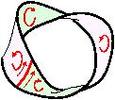 Oleg Viro's home page
Oleg Viro's home page
 Oleg Viro's home page
Oleg Viro's home page


|
| time and place |
| warm up question for the next lecture |
Although the course is a continuation of MAT621-spr09, it can be taken independently. It consists of lots of separate stories, so the title "Topics in Topology" is appropriate. The first of the topics is orientations. The notion of orientation appears in Mathematics here and there, but many issues related to it are not covered in textbooks properly. Even the very definition of orientation is formulated incorrectly in most of standard textbooks.
Goals. The goal of the course is to provide a broad introduction to the Low Dimensional Topology. This subject developed tremendously during the last 40 years. New techniques both emerged inside of it and came from other fields such as Quantum Physics, Hyperbolic Geometry and Algebra.
Objects. Low Dimensional Topology studies a great variety of objects: classical knots and links, immersions of curves to surfaces, manifolds of dimensions up to 4, surfaces in 3- and 4-manifolds, etc. Each of the objects can be presented in many ways. For example, a classical link can be presented by a planar diagram, as a closed braid, by an algebraic equation, as a Legendrian lifting of an arc immersed generically in a disk, etc. In the course a systematic study of the objects and their geometric, combinatorial and algebraic descriptions will be undertaken. We will pay attention also to the objects which appear in the context of Singularity Theory and Algebraic Geometry (both complex and real).
Invariants. The objects will be studied together with their topological invariants. The invariants will be developed and introduced gradually, as the geometric problems require. Nowadays there is a great variety of invariants. Some of them comes from the classical Algebraic Topology, but the nature of many others has not yet found a satisfactory interpretation in a traditional topology.
Prerequisites. Most of the objects and their invariants can be introduced in quite a naive way. The corresponding fragments of the course will be very elementary and independent from each other. However, for a complete understanding of the material a knowledge of elementary topology is required and some familiarity with homology would be very desirable. On the other hand, I promise to provide at a first request a short outline of the necessary theory.
Style. The material will be presented in small fragments. Each of them will be made as much independent from the others as possible. Special efforts will be made to connect the fragments to each other and to other pieces of mathematics.